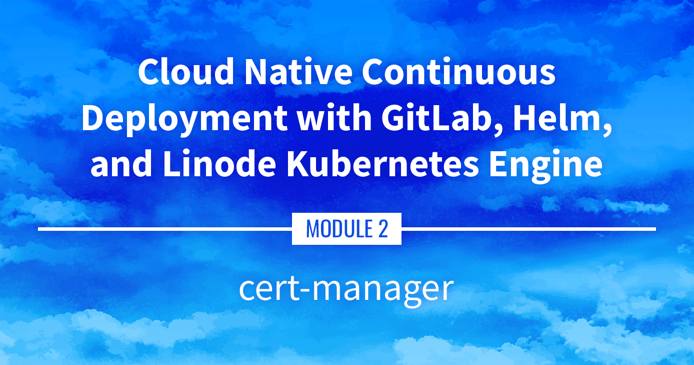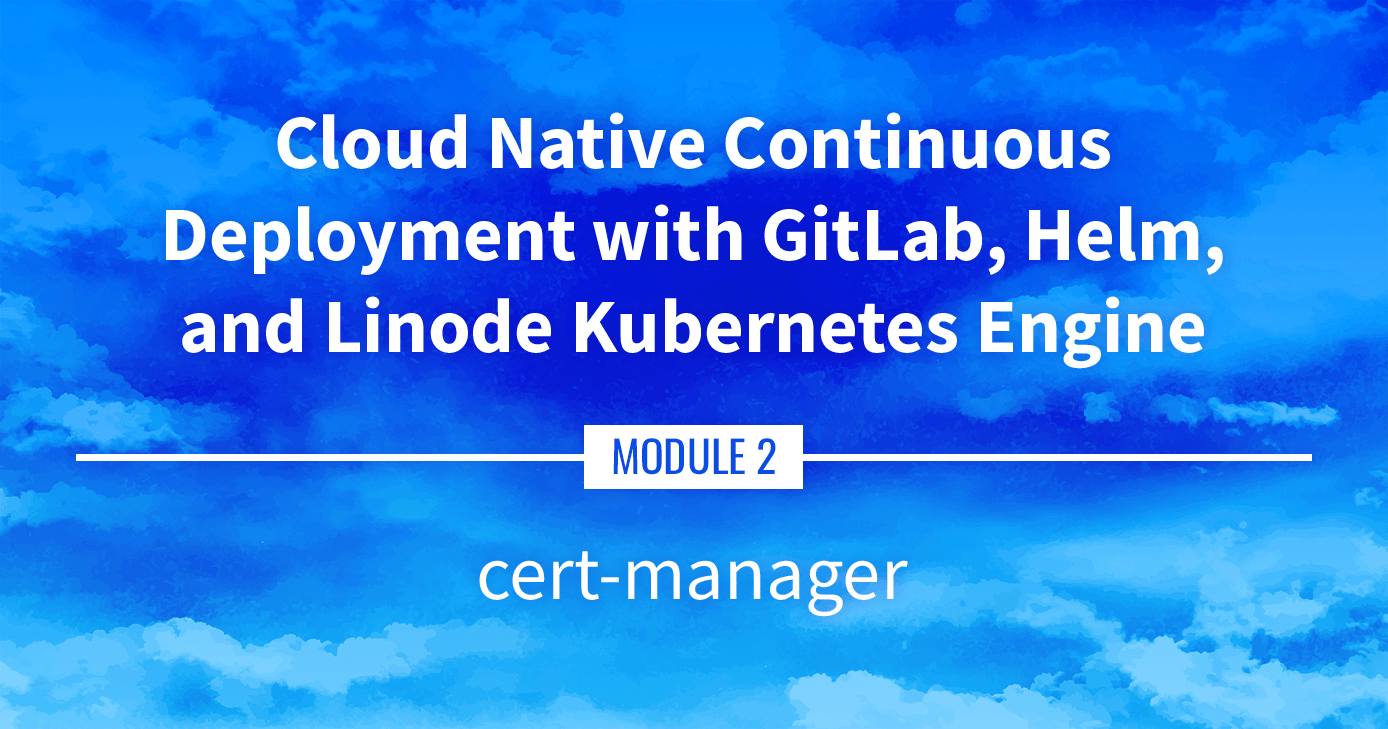Building a CD Pipeline Using LKE (Part 12): cert-manager
Traducciones al EspañolEstamos traduciendo nuestros guías y tutoriales al Español. Es posible que usted esté viendo una traducción generada automáticamente. Estamos trabajando con traductores profesionales para verificar las traducciones de nuestro sitio web. Este proyecto es un trabajo en curso.



Watch the Presentation: Register to watch this workshop, free of charge.
cert-manager
The cert-manager tool can be used to manage SSL/TLS certificates for applications within a Kubernetes cluster. This part goes over installing and configuring cert-manager, as well as obtaining your first SSL certificate through Let’s Encrypt.
Navigate the Series
- Main guide: Building a Continuous Deployment Pipeline Using LKE
- Previous section: Part 11: Prometheus and Grafana
- Next section: Part 13: CI/CD with GitLab
Presentation Text
Here’s a copy of the text contained within this section of the presentation. A link to the source file can be found within each slide of the presentation. Some formatting may have been changed.
cert-manager
- cert-manager¹ facilitates certificate signing through the Kubernetes API:
- we create a Certificate object (that’s a CRD)
- cert-manager creates a private key
- it signs that key …
- … or interacts with a certificate authority to obtain the signature
- it stores the resulting key+cert in a Secret resource
- These Secret resources can be used in many places (Ingress, mTLS, …)
¹Always lower case, words separated with a dash; see the style guide
Getting signatures
- cert-manager can use multiple Issuers (another CRD), including:
- self-signed
- cert-manager acting as a CA
- the ACME protocol (notably used by Let’s Encrypt)
- HashiCorp Vault
- Multiple issuers can be configured simultaneously
- Issuers can be available in a single namespace, or in the whole cluster (then we use the ClusterIssuer CRD)
cert-manager in action
- We will install cert-manager
- We will create a ClusterIssuer to obtain certificates with Let’s Encrypt (this will involve setting up an Ingress Controller)
- We will create a Certificate request
- cert-manager will honor that request and create a TLS Secret
Installing cert-manager
It can be installed with a YAML manifest, or with Helm
Let’s install the cert-manager Helm chart with this one-liner:
helm install cert-manager cert-manager \ --repo https://charts.jetstack.io \ --create-namespace --namespace cert-manager \ --set installCRDs=trueIf you prefer to install with a single YAML file, that’s fine too! å(see the documentation for instructions)
ClusterIssuer manifest
apiVersion: cert-manager.io/v1
kind: ClusterIssuer
metadata:
name: letsencrypt-staging
spec:
acme:
# Remember to update this if you use this manifest to obtain real certificates :)
email: hello@example.com
server: https://acme-staging-v02.api.letsencrypt.org/directory
# To use the production environment, use the following line instead:
#server: https://acme-v02.api.letsencrypt.org/directory
privateKeySecretRef:
name: issuer-letsencrypt-staging
solvers:
- http01:
ingress:
class: traefik
Creating the ClusterIssuer
- Download the file
k8s/cm-clusterissuer.yaml(or copy-paste from the previous slide) - Create the ClusterIssuer:
kubectl apply cm-clusterissuer.yaml
Certificate manifest
apiVersion: cert-manager.io/v1
kind: Certificate
metadata:
name: xyz.A.B.C.D.nip.io
spec:
secretName: xyz.A.B.C.D.nip.io
dnsNames:
- xyz.A.B.C.D.nip.io
issuerRef:
name: letsencrypt-staging
kind: ClusterIssuer
- The
name,secretName, anddnsNamesdon’t have to match - There can be multiple
dnsNames - The
issuerRefmust match the ClusterIssuer that we created earlier
Creating the Certificate
- Download the file k8s/cm-certificate.yaml (or copy-paste from the previous slide)
- Edit the Certificate to update the domain name (make sure to replace A.B.C.D with the IP address of one of your nodes!)
- Create the Certificate:
kubectl apply -f cm-certificate.yaml
What’s happening?
cert-manager will create:
- the secret key
- a Pod, a Service, and an Ingress to complete the HTTP challenge
then it waits for the challenge to complete
View the resources created by cert-manager:
kubectl get pods,services,ingresses \ --selector=acme.cert-manager.io/http01-solver=true```
HTTP challenge
The CA (in this case, Let’s Encrypt) will fetch a particular URL:
http://<our-domain>/.well-known/acme-challenge/<token>Check the path of the Ingress in particular:
kubectl describe ingress --selector=acme.cert-manager.io/http01-solver=true
And then…
- A little bit later, we will have a
kubernetes.io/tlsSecret:kubectl get secrets - Note that this might take a few minutes, because of the DNS integration!
Using the secret
For bonus points, try to use the secret in an Ingress!
This is what the manifest would look like:
apiVersion: networking.k8s.io/v1beta1 kind: Ingress metadata: name: xyz spec: tls: - secretName: xyz.A.B.C.D.nip.io hosts: - xyz.A.B.C.D.nip.io rules: ...
Automatic TLS Ingress with annotations
- It is also possible to annotate Ingress resources for cert-manager
- If we annotate an Ingress resource with
cert-manager.io/cluster-issuer=xxx:- cert-manager will detect that annotation
- it will obtain a certificate using the specified ClusterIssuer (
xxx) - it will store the key and certificate in the specified Secret
- Note: the Ingress still needs the
tlssection withsecretNameandhosts
This page was originally published on
